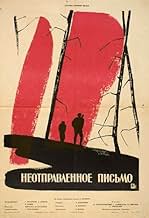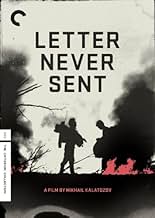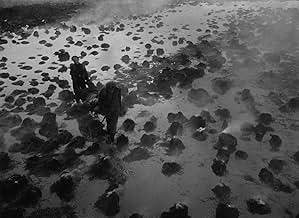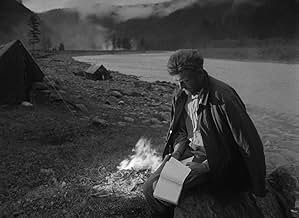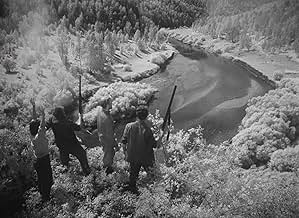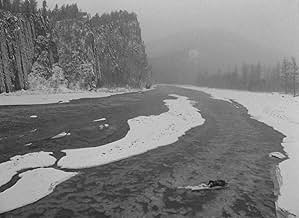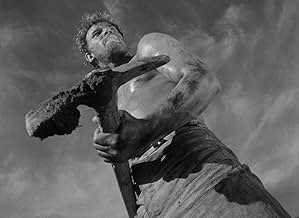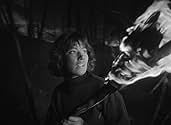ÉVALUATION IMDb
7,8/10
4,7 k
MA NOTE
Quatre géologues recherchent des diamants dans les étendues sauvages de Sibérie.Quatre géologues recherchent des diamants dans les étendues sauvages de Sibérie.Quatre géologues recherchent des diamants dans les étendues sauvages de Sibérie.
- Prix
- 1 nomination au total
Innokentiy Smoktunovskiy
- Konstantin Sabinin
- (as I. Smoktunovskiy)
Tatyana Samoylova
- Tanya
- (as T. Samoylova)
Vasiliy Livanov
- Andrey
- (as V. Livanov)
Evgeniy Urbanskiy
- Sergey Stepanovich
- (as Ye. Urbanskiy)
Galina Kozhakina
- Vera
- (as G. Kozhakina)
Avis en vedette
9Fpi
This is a totally excellent man vs. nature drama. An outstandingly dramatic soundtrack is coupled with some of the most powerful and unique visuals I've ever seen. If you thought Tarkovsky was a one-shot in the Soviet Union when it came to beautiful yet haunting images, you'll definitely think again after this movie. The characters and the story are perhaps not too well developed, but this somehow adds to the sense of not being totally in control, which is important here. It's nothing short of a tragedy that this movie is totally unknown; it would probably have been a candidate of reaching IMDb's top 50 if it were. Those looking for unknown classics should hunt this one down at all costs.
Welcome to Siberia, circa 1959 (in perfectly restored, glorious Black and White).
Although this story revolves around four 'pioneers' dropped into a vast wilderness to search for a rumored vein of diamonds (aka 'the Diamond Pipe'), the real star of the movie is cinematographer Sergei Urusevsky ("Soy Cuba," "The Cranes Are Flying").
Urusevsky is master of composition, dolly shots, and hand-held photography (when necessary). The way he frames his close-ups of the actors practically allows the audience to see into their souls.
Of course, it helps that he's shooting a top-notch Russian cast, including actress Tatyana Samojlova ("The Cranes Are Flying") whose character 'Tanya' is desperate to survive the troubling events that befall the group. Tanya is also the lone female and commands the attentions of two men in the rock-sampling group (though one is unrequited).
In addition, the visual elements are underscored aurally by composer Nikolai Kryukov's ("The Forty-first") evocative score, although he does amp up the music a bit too much in a couple of scenes. Not unusual for the time period, so set your appreciation meter back to the 50's and you won't be as bothered as I was.
The title of the film refers to not one but two letters that figure into the plot. One is a long, personal letter that is referred to in voice-over from time to time throughout the film, while the other is a love letter thought to be hidden away until it accidentally comes to light.
The plot is very straightforward so I won't spoil any surprises by detailing it here, suffice to say that the main attractions of this film are the artistic cinematography, the strong cast, and the director's choice to foreshadow plot elements by overlaying fiery images over his hardcharging trekkers.
If you've never seen any films by director Mikhail Kalatozov ("The Red Tent," "Soy Cuba," "The Cranes Are Flying"), then this one is probably as accessible as any and with a new restoration to boot, practically a MUST-SEE.
The ending alone is worth the price of admission, so check it out festival goers.
Although this story revolves around four 'pioneers' dropped into a vast wilderness to search for a rumored vein of diamonds (aka 'the Diamond Pipe'), the real star of the movie is cinematographer Sergei Urusevsky ("Soy Cuba," "The Cranes Are Flying").
Urusevsky is master of composition, dolly shots, and hand-held photography (when necessary). The way he frames his close-ups of the actors practically allows the audience to see into their souls.
Of course, it helps that he's shooting a top-notch Russian cast, including actress Tatyana Samojlova ("The Cranes Are Flying") whose character 'Tanya' is desperate to survive the troubling events that befall the group. Tanya is also the lone female and commands the attentions of two men in the rock-sampling group (though one is unrequited).
In addition, the visual elements are underscored aurally by composer Nikolai Kryukov's ("The Forty-first") evocative score, although he does amp up the music a bit too much in a couple of scenes. Not unusual for the time period, so set your appreciation meter back to the 50's and you won't be as bothered as I was.
The title of the film refers to not one but two letters that figure into the plot. One is a long, personal letter that is referred to in voice-over from time to time throughout the film, while the other is a love letter thought to be hidden away until it accidentally comes to light.
The plot is very straightforward so I won't spoil any surprises by detailing it here, suffice to say that the main attractions of this film are the artistic cinematography, the strong cast, and the director's choice to foreshadow plot elements by overlaying fiery images over his hardcharging trekkers.
If you've never seen any films by director Mikhail Kalatozov ("The Red Tent," "Soy Cuba," "The Cranes Are Flying"), then this one is probably as accessible as any and with a new restoration to boot, practically a MUST-SEE.
The ending alone is worth the price of admission, so check it out festival goers.
Among a panoply of scintillating things about this film is Sergei Urusevsky's deft black-and-white cinematography, much of it hand-held. Urusevsky seems to understand semiotics deeply, and his shots are often protean, shifting angle or perspective during a take to wring extra emotional import from it. I found myself rewinding many sequences and rewatching because of how well Urusevky, arguably the greatest Soviet era lensman, can minimally change vantage or tilt and bring fresh meaning cascading from the actors.
"Letter Never Sent" has communistic political messages in it, but is sumptuously acted by a small cast with a good sense of ensemble. Heat and cold, fire and ice, land and water, remote wildness and safe civilization all exist here in dynamic tension. The version in digital circulation is lovingly restored. A must-watch, especially for admirers of other quintessential Russian filmmakers such as Tarkovsy.
"Letter Never Sent" has communistic political messages in it, but is sumptuously acted by a small cast with a good sense of ensemble. Heat and cold, fire and ice, land and water, remote wildness and safe civilization all exist here in dynamic tension. The version in digital circulation is lovingly restored. A must-watch, especially for admirers of other quintessential Russian filmmakers such as Tarkovsy.
This robust survival adventure follows a team of Soviet geologists stranded in the wilderness of Siberia after a forest fire severs their communication link with civilization. The opening dedication to Socialist heroes everywhere and the noble sacrifices made by each character carry the story dangerously close to propaganda, but the intensity of their ordeal (through smoke and fire, over snow and ice, across mountains and tundra) thankfully overwhelms the political simplicity of the script. Unfortunately, it also overwhelms the initial hints of tension between each of the four characters (three male, one female) after the struggle to survive becomes paramount. The sense of isolation and exposure is numbing; the film was directed with a strong sense of visual drama (including more than one knockout montage), showing everything an audience would ever want to know about being lost in Siberia.
Saw this at Tribeca Film Festival in Spring 2007, and was absolutely floored. I walked out of the theater afterword amazed at what I'd seen and thrilled that such an amazing film existed and had been maintained by a tiny number of appreciators in such excellent quality for so long.
The story is not the strong point of the movie. Rather, as with Terence Malick films, the story is just a starting point for the film, which is another beast entirely. What shines and carries the film from scene to scene is the cinematography. I didn't know if this was happened elsewhere at the time, but I didn't expect to see hand-held camera work in a 1959 Russian film, let alone the kind of early spinning, impossibly-filmed shot that appears early in the film. Later, there is a sequence that makes me long to know how they created the opportunity to film in such conditions.
If you've read this far, you must track down this movie. My understanding is that Francis Coppola has a California archive maintain the only copy in the Americas, and that it's usually shown just one a year.
The story is not the strong point of the movie. Rather, as with Terence Malick films, the story is just a starting point for the film, which is another beast entirely. What shines and carries the film from scene to scene is the cinematography. I didn't know if this was happened elsewhere at the time, but I didn't expect to see hand-held camera work in a 1959 Russian film, let alone the kind of early spinning, impossibly-filmed shot that appears early in the film. Later, there is a sequence that makes me long to know how they created the opportunity to film in such conditions.
If you've read this far, you must track down this movie. My understanding is that Francis Coppola has a California archive maintain the only copy in the Americas, and that it's usually shown just one a year.
Le saviez-vous
- AnecdotesIn 1995 the film was restored by and shown in United States upon the financial support from Francis Coppola.
- Citations
Andrey: Sergei, you've fallen in love with a girl who loves someone else, and that man loves her. From the moral standpoint it's wrong.
Sergey Stepanovich: I don't give a damn about your bookish morale. I'm in love.
Andrey: That's an egoist speaking.
- ConnexionsFeatured in Fejezetek a film történetéböl: A szovjet film 1953-1970 (1990)
Meilleurs choix
Connectez-vous pour évaluer et surveiller les recommandations personnalisées
- How long is Letter Never Sent?Propulsé par Alexa
Détails
- Date de sortie
- Pays d’origine
- Site officiel
- Langue
- Aussi connu sous le nom de
- Letter Never Sent
- Lieux de tournage
- Mosfilm Studios, Moscou, Russie(Studio)
- société de production
- Consultez plus de crédits d'entreprise sur IMDbPro
- Durée1 heure 36 minutes
- Couleur
- Mixage
- Rapport de forme
- 1.37 : 1
Contribuer à cette page
Suggérer une modification ou ajouter du contenu manquant

Lacune principale
By what name was Neotpravlennoye pismo (1960) officially released in India in English?
Répondre
